Report on Digital Life and Learning of Young People: Social Media
VerifiedAdded on 2023/01/11
|7
|1930
|43
Report
AI Summary
This report delves into the multifaceted impact of social media on the digital lives and learning of young people. It begins by introducing the broad scope of digital life and focusing specifically on social media's influence. The report outlines how social media platforms, such as Instagram, Facebook, and YouTube, are integral to youth culture, affecting communication, commerce, and even education. It then addresses relevant policies, such as Australia's Enhancing Online Safety Act, emphasizing the need for responsible usage. A significant portion explores both the positive and negative impacts of social media, including networking, learning opportunities, youth work, safety concerns, health issues, fraud, and negative influences. The report incorporates critical reviews from authors like Way and Malvini Redden, offering a balanced perspective on the subject. The conclusion underscores the essential role of social media in the digital lives of young people, highlighting the need for awareness, ethical practices, and continuous evaluation to ensure a secure and beneficial online experience. The report is a student contribution available on Desklib, a platform that provides AI-based study tools for students.
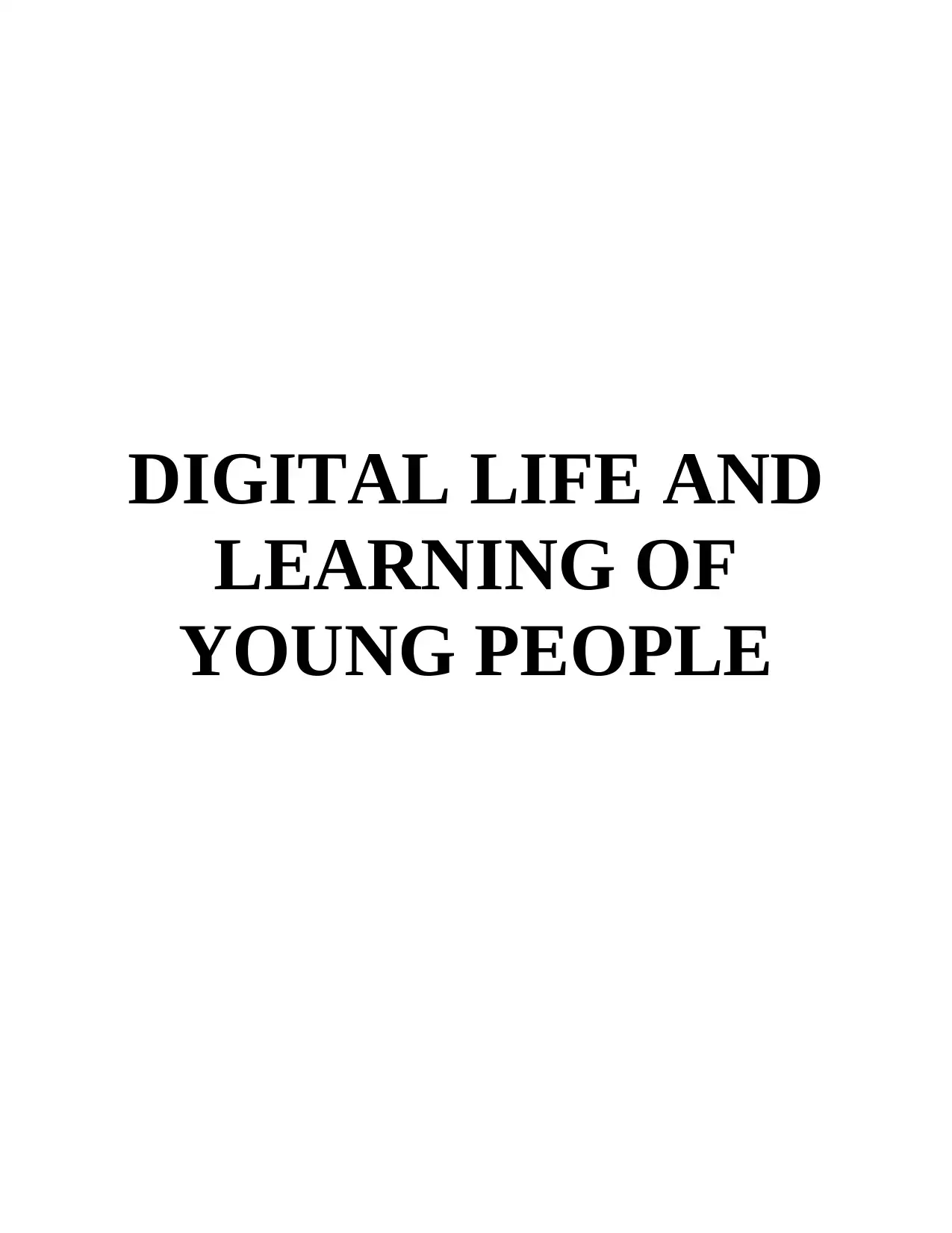
DIGITAL LIFE AND
LEARNING OF
YOUNG PEOPLE
LEARNING OF
YOUNG PEOPLE
Paraphrase This Document
Need a fresh take? Get an instant paraphrase of this document with our AI Paraphraser
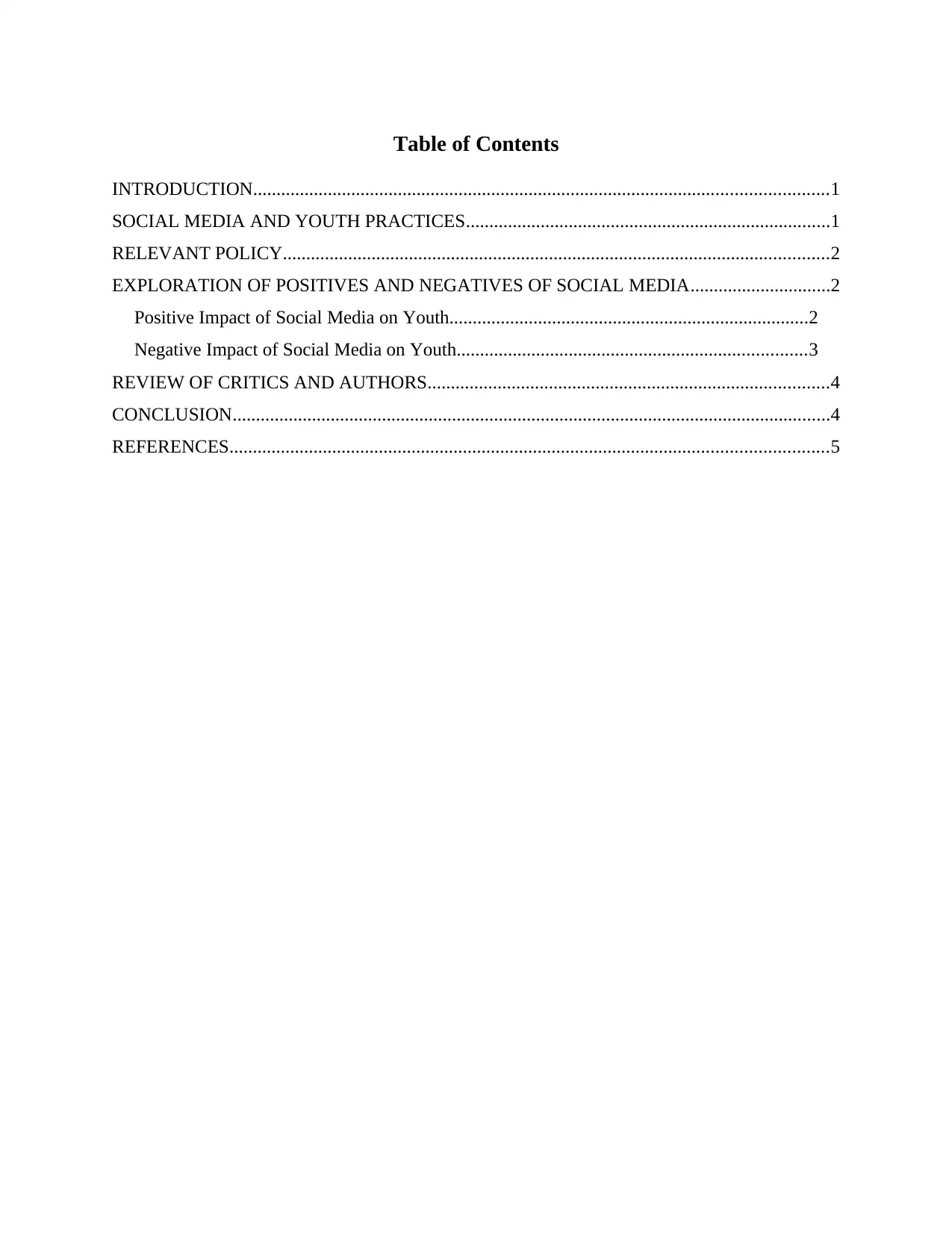
Table of Contents
INTRODUCTION...........................................................................................................................1
SOCIAL MEDIA AND YOUTH PRACTICES..............................................................................1
RELEVANT POLICY.....................................................................................................................2
EXPLORATION OF POSITIVES AND NEGATIVES OF SOCIAL MEDIA..............................2
Positive Impact of Social Media on Youth.............................................................................2
Negative Impact of Social Media on Youth...........................................................................3
REVIEW OF CRITICS AND AUTHORS......................................................................................4
CONCLUSION................................................................................................................................4
REFERENCES................................................................................................................................5
INTRODUCTION...........................................................................................................................1
SOCIAL MEDIA AND YOUTH PRACTICES..............................................................................1
RELEVANT POLICY.....................................................................................................................2
EXPLORATION OF POSITIVES AND NEGATIVES OF SOCIAL MEDIA..............................2
Positive Impact of Social Media on Youth.............................................................................2
Negative Impact of Social Media on Youth...........................................................................3
REVIEW OF CRITICS AND AUTHORS......................................................................................4
CONCLUSION................................................................................................................................4
REFERENCES................................................................................................................................5
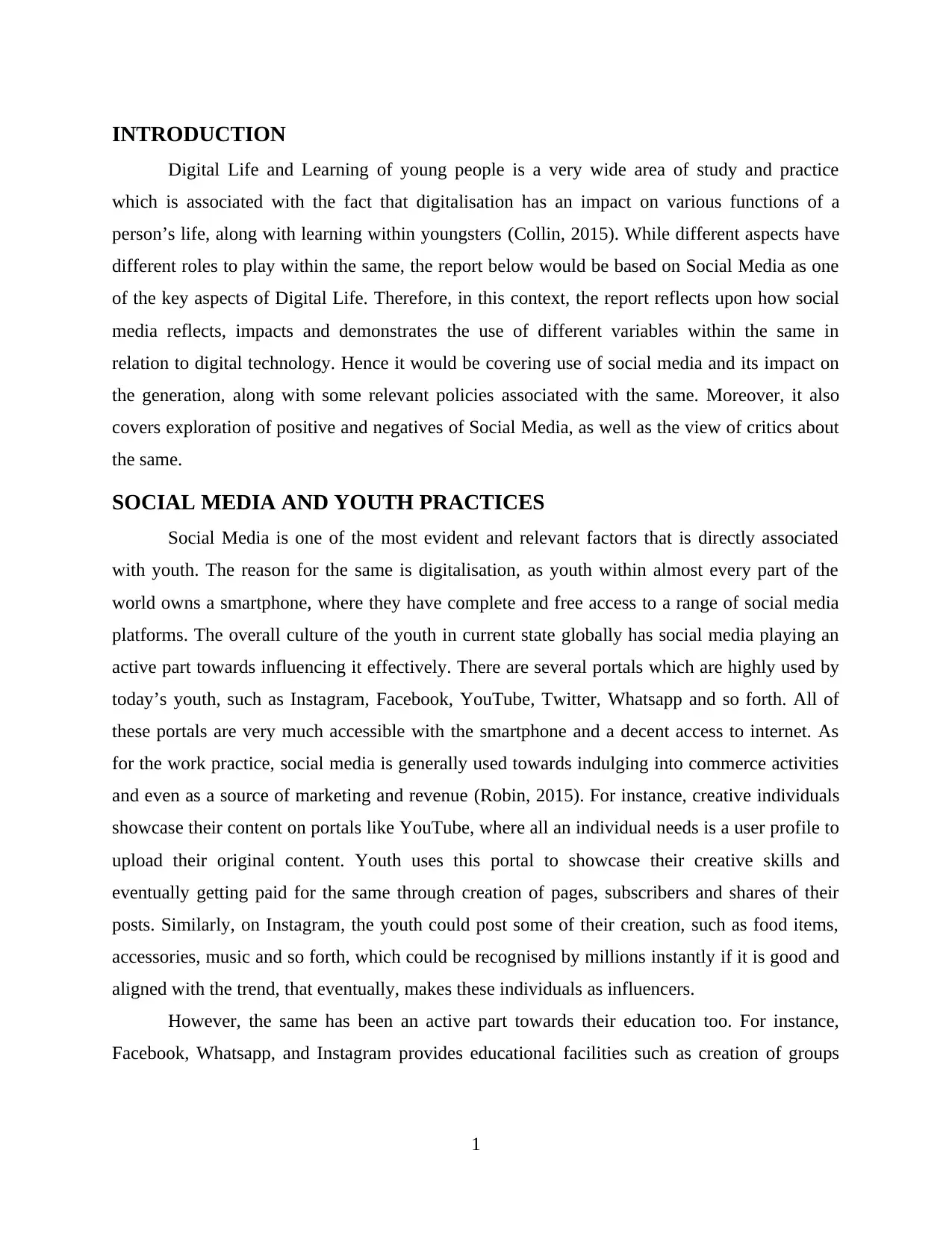
INTRODUCTION
Digital Life and Learning of young people is a very wide area of study and practice
which is associated with the fact that digitalisation has an impact on various functions of a
person’s life, along with learning within youngsters (Collin, 2015). While different aspects have
different roles to play within the same, the report below would be based on Social Media as one
of the key aspects of Digital Life. Therefore, in this context, the report reflects upon how social
media reflects, impacts and demonstrates the use of different variables within the same in
relation to digital technology. Hence it would be covering use of social media and its impact on
the generation, along with some relevant policies associated with the same. Moreover, it also
covers exploration of positive and negatives of Social Media, as well as the view of critics about
the same.
SOCIAL MEDIA AND YOUTH PRACTICES
Social Media is one of the most evident and relevant factors that is directly associated
with youth. The reason for the same is digitalisation, as youth within almost every part of the
world owns a smartphone, where they have complete and free access to a range of social media
platforms. The overall culture of the youth in current state globally has social media playing an
active part towards influencing it effectively. There are several portals which are highly used by
today’s youth, such as Instagram, Facebook, YouTube, Twitter, Whatsapp and so forth. All of
these portals are very much accessible with the smartphone and a decent access to internet. As
for the work practice, social media is generally used towards indulging into commerce activities
and even as a source of marketing and revenue (Robin, 2015). For instance, creative individuals
showcase their content on portals like YouTube, where all an individual needs is a user profile to
upload their original content. Youth uses this portal to showcase their creative skills and
eventually getting paid for the same through creation of pages, subscribers and shares of their
posts. Similarly, on Instagram, the youth could post some of their creation, such as food items,
accessories, music and so forth, which could be recognised by millions instantly if it is good and
aligned with the trend, that eventually, makes these individuals as influencers.
However, the same has been an active part towards their education too. For instance,
Facebook, Whatsapp, and Instagram provides educational facilities such as creation of groups
1
Digital Life and Learning of young people is a very wide area of study and practice
which is associated with the fact that digitalisation has an impact on various functions of a
person’s life, along with learning within youngsters (Collin, 2015). While different aspects have
different roles to play within the same, the report below would be based on Social Media as one
of the key aspects of Digital Life. Therefore, in this context, the report reflects upon how social
media reflects, impacts and demonstrates the use of different variables within the same in
relation to digital technology. Hence it would be covering use of social media and its impact on
the generation, along with some relevant policies associated with the same. Moreover, it also
covers exploration of positive and negatives of Social Media, as well as the view of critics about
the same.
SOCIAL MEDIA AND YOUTH PRACTICES
Social Media is one of the most evident and relevant factors that is directly associated
with youth. The reason for the same is digitalisation, as youth within almost every part of the
world owns a smartphone, where they have complete and free access to a range of social media
platforms. The overall culture of the youth in current state globally has social media playing an
active part towards influencing it effectively. There are several portals which are highly used by
today’s youth, such as Instagram, Facebook, YouTube, Twitter, Whatsapp and so forth. All of
these portals are very much accessible with the smartphone and a decent access to internet. As
for the work practice, social media is generally used towards indulging into commerce activities
and even as a source of marketing and revenue (Robin, 2015). For instance, creative individuals
showcase their content on portals like YouTube, where all an individual needs is a user profile to
upload their original content. Youth uses this portal to showcase their creative skills and
eventually getting paid for the same through creation of pages, subscribers and shares of their
posts. Similarly, on Instagram, the youth could post some of their creation, such as food items,
accessories, music and so forth, which could be recognised by millions instantly if it is good and
aligned with the trend, that eventually, makes these individuals as influencers.
However, the same has been an active part towards their education too. For instance,
Facebook, Whatsapp, and Instagram provides educational facilities such as creation of groups
1
⊘ This is a preview!⊘
Do you want full access?
Subscribe today to unlock all pages.

Trusted by 1+ million students worldwide
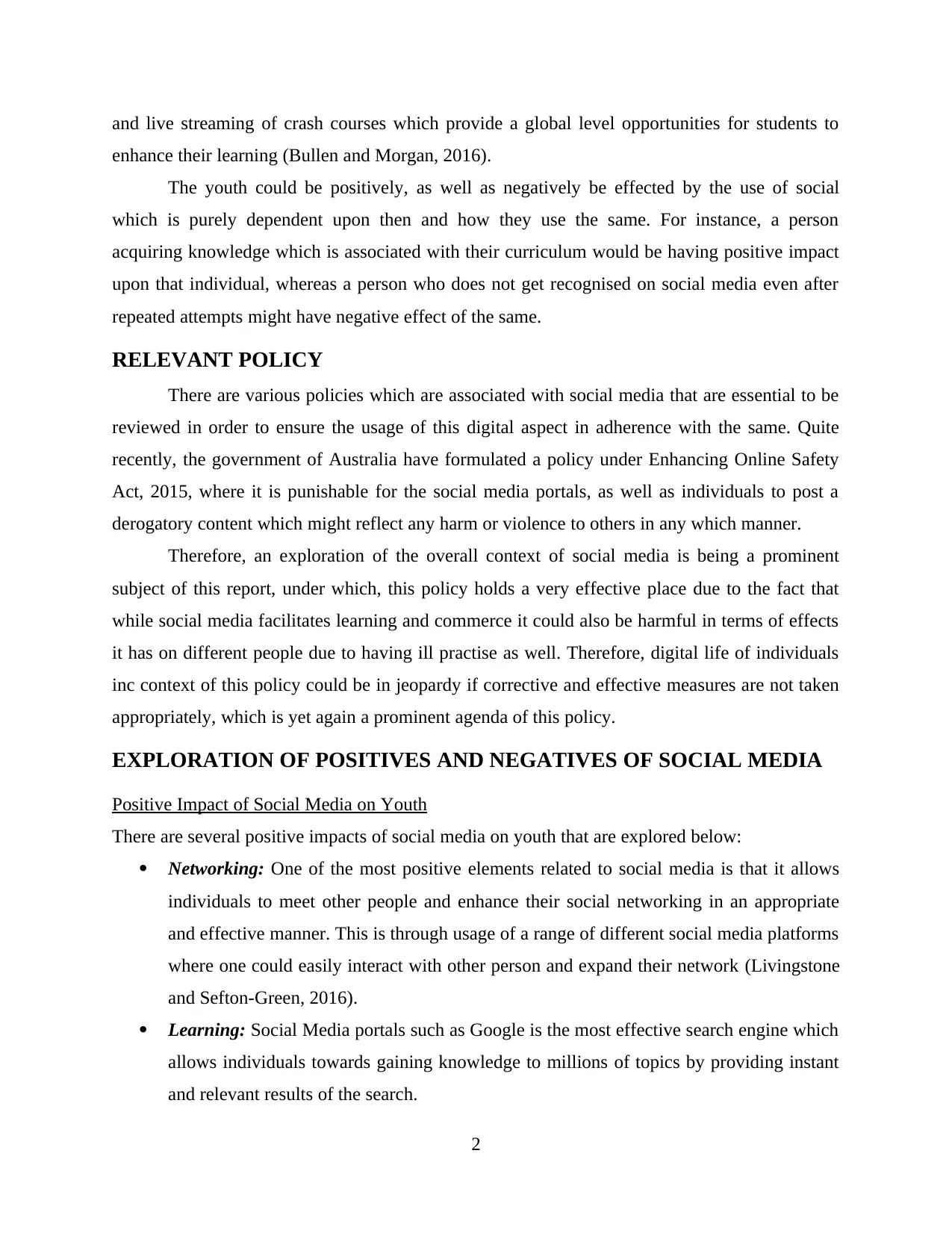
and live streaming of crash courses which provide a global level opportunities for students to
enhance their learning (Bullen and Morgan, 2016).
The youth could be positively, as well as negatively be effected by the use of social
which is purely dependent upon then and how they use the same. For instance, a person
acquiring knowledge which is associated with their curriculum would be having positive impact
upon that individual, whereas a person who does not get recognised on social media even after
repeated attempts might have negative effect of the same.
RELEVANT POLICY
There are various policies which are associated with social media that are essential to be
reviewed in order to ensure the usage of this digital aspect in adherence with the same. Quite
recently, the government of Australia have formulated a policy under Enhancing Online Safety
Act, 2015, where it is punishable for the social media portals, as well as individuals to post a
derogatory content which might reflect any harm or violence to others in any which manner.
Therefore, an exploration of the overall context of social media is being a prominent
subject of this report, under which, this policy holds a very effective place due to the fact that
while social media facilitates learning and commerce it could also be harmful in terms of effects
it has on different people due to having ill practise as well. Therefore, digital life of individuals
inc context of this policy could be in jeopardy if corrective and effective measures are not taken
appropriately, which is yet again a prominent agenda of this policy.
EXPLORATION OF POSITIVES AND NEGATIVES OF SOCIAL MEDIA
Positive Impact of Social Media on Youth
There are several positive impacts of social media on youth that are explored below:
Networking: One of the most positive elements related to social media is that it allows
individuals to meet other people and enhance their social networking in an appropriate
and effective manner. This is through usage of a range of different social media platforms
where one could easily interact with other person and expand their network (Livingstone
and Sefton-Green, 2016).
Learning: Social Media portals such as Google is the most effective search engine which
allows individuals towards gaining knowledge to millions of topics by providing instant
and relevant results of the search.
2
enhance their learning (Bullen and Morgan, 2016).
The youth could be positively, as well as negatively be effected by the use of social
which is purely dependent upon then and how they use the same. For instance, a person
acquiring knowledge which is associated with their curriculum would be having positive impact
upon that individual, whereas a person who does not get recognised on social media even after
repeated attempts might have negative effect of the same.
RELEVANT POLICY
There are various policies which are associated with social media that are essential to be
reviewed in order to ensure the usage of this digital aspect in adherence with the same. Quite
recently, the government of Australia have formulated a policy under Enhancing Online Safety
Act, 2015, where it is punishable for the social media portals, as well as individuals to post a
derogatory content which might reflect any harm or violence to others in any which manner.
Therefore, an exploration of the overall context of social media is being a prominent
subject of this report, under which, this policy holds a very effective place due to the fact that
while social media facilitates learning and commerce it could also be harmful in terms of effects
it has on different people due to having ill practise as well. Therefore, digital life of individuals
inc context of this policy could be in jeopardy if corrective and effective measures are not taken
appropriately, which is yet again a prominent agenda of this policy.
EXPLORATION OF POSITIVES AND NEGATIVES OF SOCIAL MEDIA
Positive Impact of Social Media on Youth
There are several positive impacts of social media on youth that are explored below:
Networking: One of the most positive elements related to social media is that it allows
individuals to meet other people and enhance their social networking in an appropriate
and effective manner. This is through usage of a range of different social media platforms
where one could easily interact with other person and expand their network (Livingstone
and Sefton-Green, 2016).
Learning: Social Media portals such as Google is the most effective search engine which
allows individuals towards gaining knowledge to millions of topics by providing instant
and relevant results of the search.
2
Paraphrase This Document
Need a fresh take? Get an instant paraphrase of this document with our AI Paraphraser
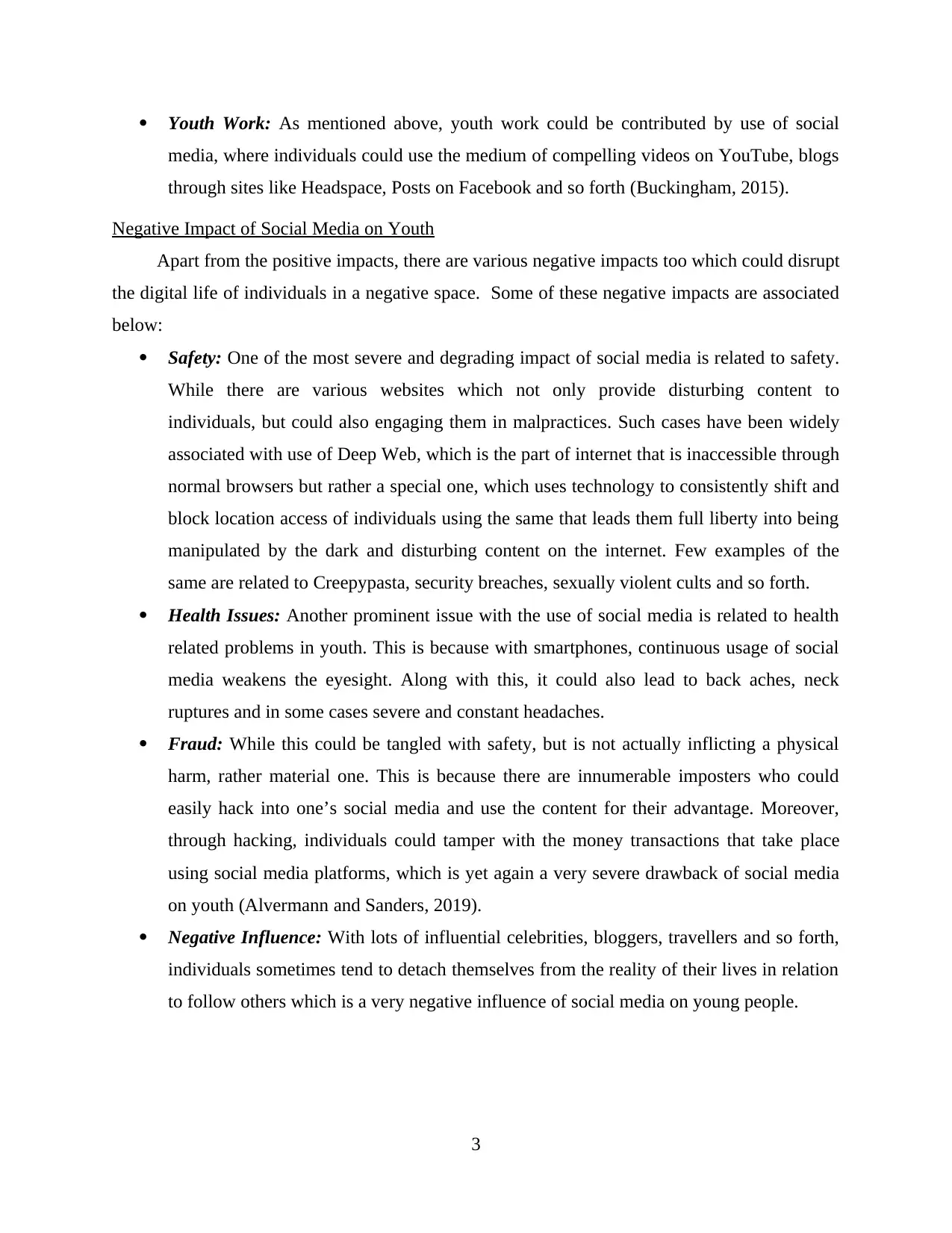
Youth Work: As mentioned above, youth work could be contributed by use of social
media, where individuals could use the medium of compelling videos on YouTube, blogs
through sites like Headspace, Posts on Facebook and so forth (Buckingham, 2015).
Negative Impact of Social Media on Youth
Apart from the positive impacts, there are various negative impacts too which could disrupt
the digital life of individuals in a negative space. Some of these negative impacts are associated
below:
Safety: One of the most severe and degrading impact of social media is related to safety.
While there are various websites which not only provide disturbing content to
individuals, but could also engaging them in malpractices. Such cases have been widely
associated with use of Deep Web, which is the part of internet that is inaccessible through
normal browsers but rather a special one, which uses technology to consistently shift and
block location access of individuals using the same that leads them full liberty into being
manipulated by the dark and disturbing content on the internet. Few examples of the
same are related to Creepypasta, security breaches, sexually violent cults and so forth.
Health Issues: Another prominent issue with the use of social media is related to health
related problems in youth. This is because with smartphones, continuous usage of social
media weakens the eyesight. Along with this, it could also lead to back aches, neck
ruptures and in some cases severe and constant headaches.
Fraud: While this could be tangled with safety, but is not actually inflicting a physical
harm, rather material one. This is because there are innumerable imposters who could
easily hack into one’s social media and use the content for their advantage. Moreover,
through hacking, individuals could tamper with the money transactions that take place
using social media platforms, which is yet again a very severe drawback of social media
on youth (Alvermann and Sanders, 2019).
Negative Influence: With lots of influential celebrities, bloggers, travellers and so forth,
individuals sometimes tend to detach themselves from the reality of their lives in relation
to follow others which is a very negative influence of social media on young people.
3
media, where individuals could use the medium of compelling videos on YouTube, blogs
through sites like Headspace, Posts on Facebook and so forth (Buckingham, 2015).
Negative Impact of Social Media on Youth
Apart from the positive impacts, there are various negative impacts too which could disrupt
the digital life of individuals in a negative space. Some of these negative impacts are associated
below:
Safety: One of the most severe and degrading impact of social media is related to safety.
While there are various websites which not only provide disturbing content to
individuals, but could also engaging them in malpractices. Such cases have been widely
associated with use of Deep Web, which is the part of internet that is inaccessible through
normal browsers but rather a special one, which uses technology to consistently shift and
block location access of individuals using the same that leads them full liberty into being
manipulated by the dark and disturbing content on the internet. Few examples of the
same are related to Creepypasta, security breaches, sexually violent cults and so forth.
Health Issues: Another prominent issue with the use of social media is related to health
related problems in youth. This is because with smartphones, continuous usage of social
media weakens the eyesight. Along with this, it could also lead to back aches, neck
ruptures and in some cases severe and constant headaches.
Fraud: While this could be tangled with safety, but is not actually inflicting a physical
harm, rather material one. This is because there are innumerable imposters who could
easily hack into one’s social media and use the content for their advantage. Moreover,
through hacking, individuals could tamper with the money transactions that take place
using social media platforms, which is yet again a very severe drawback of social media
on youth (Alvermann and Sanders, 2019).
Negative Influence: With lots of influential celebrities, bloggers, travellers and so forth,
individuals sometimes tend to detach themselves from the reality of their lives in relation
to follow others which is a very negative influence of social media on young people.
3
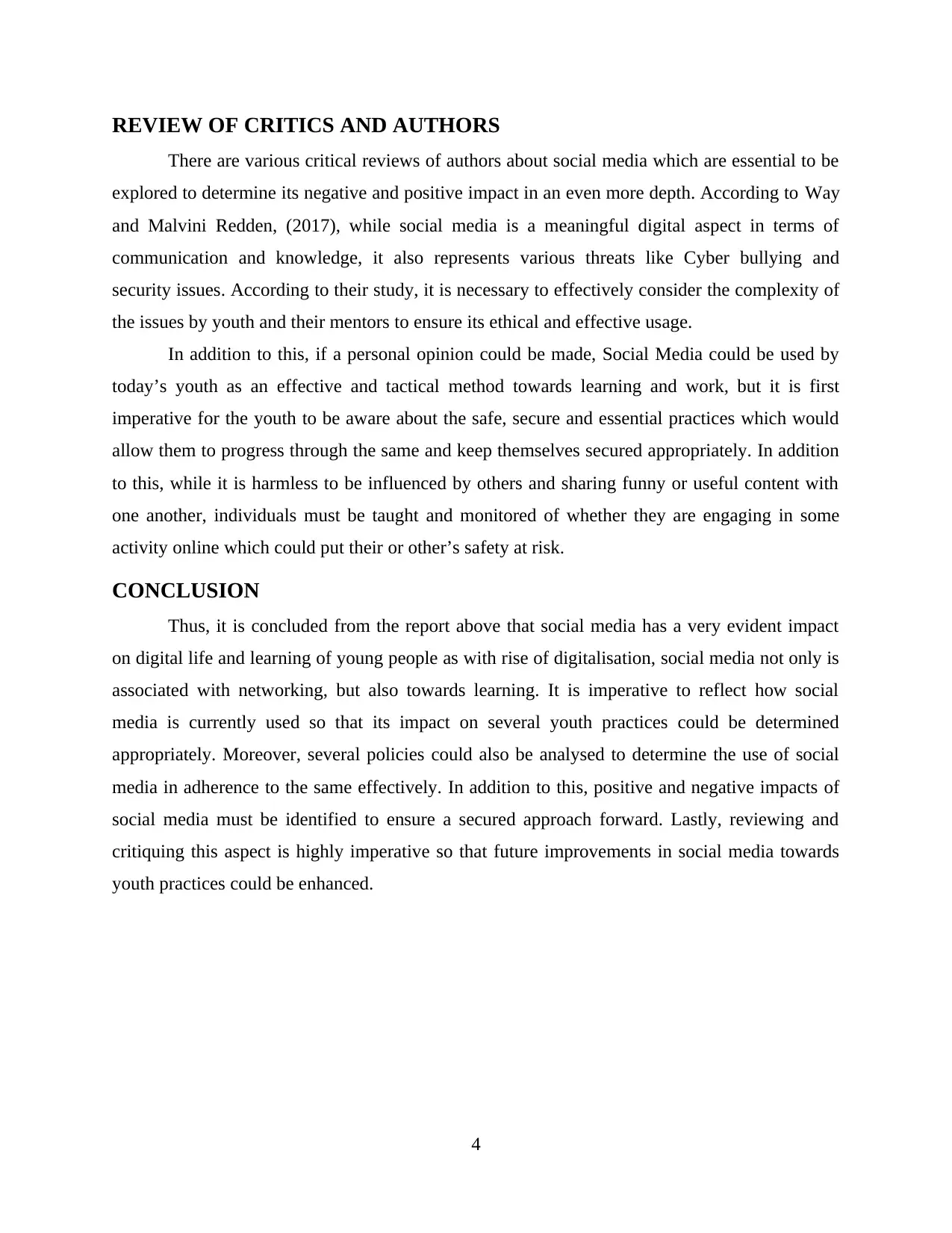
REVIEW OF CRITICS AND AUTHORS
There are various critical reviews of authors about social media which are essential to be
explored to determine its negative and positive impact in an even more depth. According to Way
and Malvini Redden, (2017), while social media is a meaningful digital aspect in terms of
communication and knowledge, it also represents various threats like Cyber bullying and
security issues. According to their study, it is necessary to effectively consider the complexity of
the issues by youth and their mentors to ensure its ethical and effective usage.
In addition to this, if a personal opinion could be made, Social Media could be used by
today’s youth as an effective and tactical method towards learning and work, but it is first
imperative for the youth to be aware about the safe, secure and essential practices which would
allow them to progress through the same and keep themselves secured appropriately. In addition
to this, while it is harmless to be influenced by others and sharing funny or useful content with
one another, individuals must be taught and monitored of whether they are engaging in some
activity online which could put their or other’s safety at risk.
CONCLUSION
Thus, it is concluded from the report above that social media has a very evident impact
on digital life and learning of young people as with rise of digitalisation, social media not only is
associated with networking, but also towards learning. It is imperative to reflect how social
media is currently used so that its impact on several youth practices could be determined
appropriately. Moreover, several policies could also be analysed to determine the use of social
media in adherence to the same effectively. In addition to this, positive and negative impacts of
social media must be identified to ensure a secured approach forward. Lastly, reviewing and
critiquing this aspect is highly imperative so that future improvements in social media towards
youth practices could be enhanced.
4
There are various critical reviews of authors about social media which are essential to be
explored to determine its negative and positive impact in an even more depth. According to Way
and Malvini Redden, (2017), while social media is a meaningful digital aspect in terms of
communication and knowledge, it also represents various threats like Cyber bullying and
security issues. According to their study, it is necessary to effectively consider the complexity of
the issues by youth and their mentors to ensure its ethical and effective usage.
In addition to this, if a personal opinion could be made, Social Media could be used by
today’s youth as an effective and tactical method towards learning and work, but it is first
imperative for the youth to be aware about the safe, secure and essential practices which would
allow them to progress through the same and keep themselves secured appropriately. In addition
to this, while it is harmless to be influenced by others and sharing funny or useful content with
one another, individuals must be taught and monitored of whether they are engaging in some
activity online which could put their or other’s safety at risk.
CONCLUSION
Thus, it is concluded from the report above that social media has a very evident impact
on digital life and learning of young people as with rise of digitalisation, social media not only is
associated with networking, but also towards learning. It is imperative to reflect how social
media is currently used so that its impact on several youth practices could be determined
appropriately. Moreover, several policies could also be analysed to determine the use of social
media in adherence to the same effectively. In addition to this, positive and negative impacts of
social media must be identified to ensure a secured approach forward. Lastly, reviewing and
critiquing this aspect is highly imperative so that future improvements in social media towards
youth practices could be enhanced.
4
⊘ This is a preview!⊘
Do you want full access?
Subscribe today to unlock all pages.

Trusted by 1+ million students worldwide
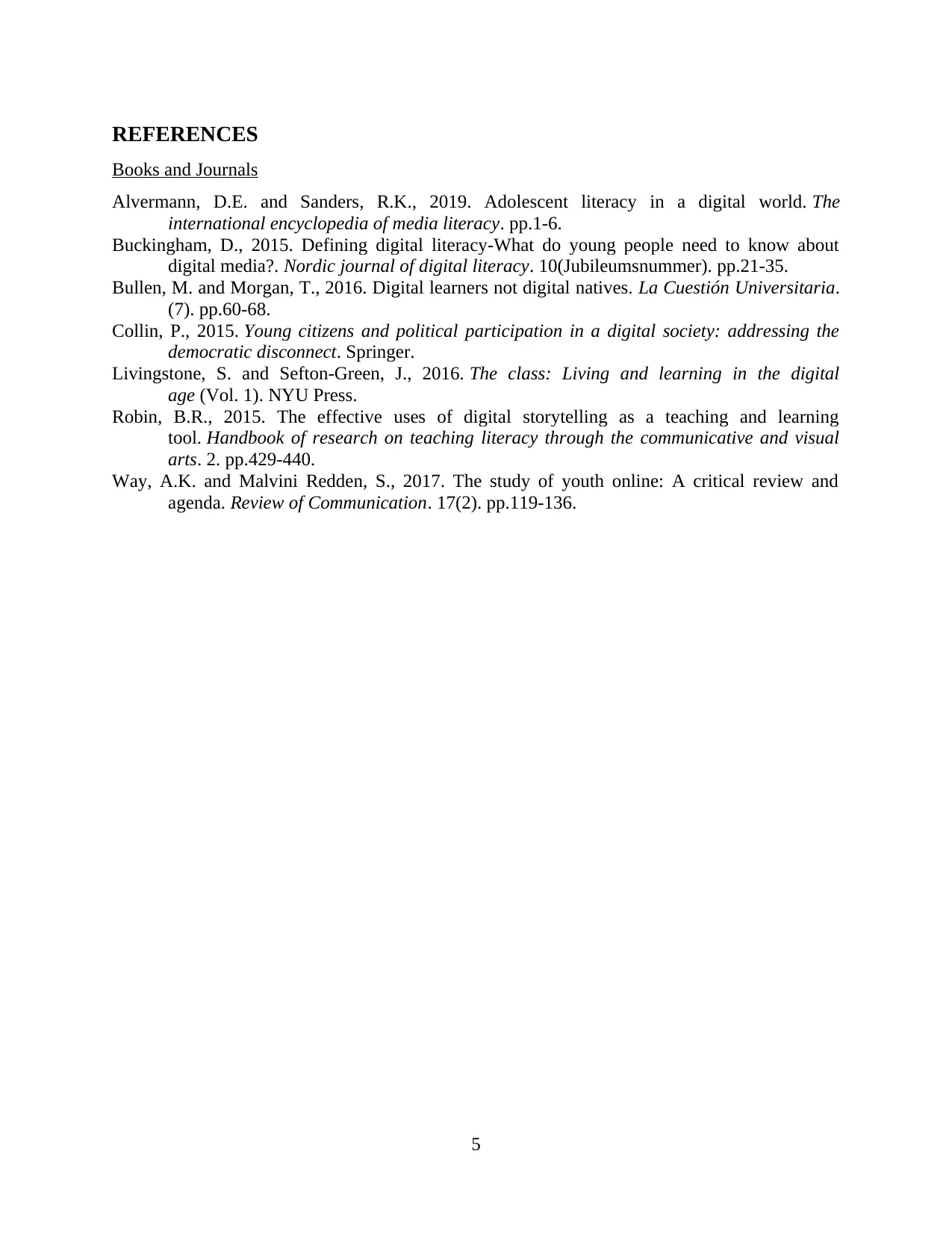
REFERENCES
Books and Journals
Alvermann, D.E. and Sanders, R.K., 2019. Adolescent literacy in a digital world. The
international encyclopedia of media literacy. pp.1-6.
Buckingham, D., 2015. Defining digital literacy-What do young people need to know about
digital media?. Nordic journal of digital literacy. 10(Jubileumsnummer). pp.21-35.
Bullen, M. and Morgan, T., 2016. Digital learners not digital natives. La Cuestión Universitaria.
(7). pp.60-68.
Collin, P., 2015. Young citizens and political participation in a digital society: addressing the
democratic disconnect. Springer.
Livingstone, S. and Sefton-Green, J., 2016. The class: Living and learning in the digital
age (Vol. 1). NYU Press.
Robin, B.R., 2015. The effective uses of digital storytelling as a teaching and learning
tool. Handbook of research on teaching literacy through the communicative and visual
arts. 2. pp.429-440.
Way, A.K. and Malvini Redden, S., 2017. The study of youth online: A critical review and
agenda. Review of Communication. 17(2). pp.119-136.
5
Books and Journals
Alvermann, D.E. and Sanders, R.K., 2019. Adolescent literacy in a digital world. The
international encyclopedia of media literacy. pp.1-6.
Buckingham, D., 2015. Defining digital literacy-What do young people need to know about
digital media?. Nordic journal of digital literacy. 10(Jubileumsnummer). pp.21-35.
Bullen, M. and Morgan, T., 2016. Digital learners not digital natives. La Cuestión Universitaria.
(7). pp.60-68.
Collin, P., 2015. Young citizens and political participation in a digital society: addressing the
democratic disconnect. Springer.
Livingstone, S. and Sefton-Green, J., 2016. The class: Living and learning in the digital
age (Vol. 1). NYU Press.
Robin, B.R., 2015. The effective uses of digital storytelling as a teaching and learning
tool. Handbook of research on teaching literacy through the communicative and visual
arts. 2. pp.429-440.
Way, A.K. and Malvini Redden, S., 2017. The study of youth online: A critical review and
agenda. Review of Communication. 17(2). pp.119-136.
5
1 out of 7
Related Documents
Your All-in-One AI-Powered Toolkit for Academic Success.
+13062052269
info@desklib.com
Available 24*7 on WhatsApp / Email
![[object Object]](/_next/static/media/star-bottom.7253800d.svg)
Unlock your academic potential
Copyright © 2020–2025 A2Z Services. All Rights Reserved. Developed and managed by ZUCOL.





